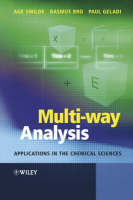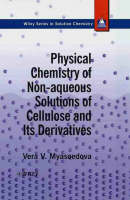Multi-way Analysis
 -15%
portes grátis
-15%
portes grátis
Multi-way Analysis
Applications in the Chemical Sciences
Geladi, Paul; Smilde, Age K.; Bro, Rasmus
John Wiley & Sons Inc
08/2004
396
Dura
Inglês
9780471986911
15 a 20 dias
742
Nomenclature and Conventions.
1 Introduction.
1.1 What is multi-way analysis?
1.2 Conceptual aspects of multi-way data analysis.
1.3 Hierarchy of multivariate data structures in chemistry.
1.4 Principal component analysis and PARAFAC.
1.5 Summary.
2 Array definitions and properties.
2.1 Introduction.
2.2 Rows, columns and tubes; frontal, lateral and horizontal slices.
2.3 Elementary operations.
2.4 Linearity concepts.
2.5 Rank of two-way arrays.
2.6 Rank of three-way arrays.
2.7 Algebra of multi-way analysis.
2.8 Summary.
Appendix 2.A.
3 Two-way component and regression models.
3.1 Models for two-way one-block data analysis: component models.
3.2 Models for two-way two-block data analysis: regression models.
3.3 Summary.
Appendix 3.A: some PCA results.
Appendix 3.B: PLS algorithms.
4 Three-way component and regression models.
4.1 Historical introduction to multi-way models.
4.2 Models for three-way one-block data: three-way component models.
4.3 Models for three-way two-block data: three-way regression models.
4.4 Summary.
Appendix 4.A: alternative notation for the PARAFAC model.
Appendix 4.B: alternative notations for the Tucker3 model.
5 Some properties of three-way component models.
5.1 Relationships between three-way component models.
5.2 Rotational freedom and uniqueness in three-way component models.
5.3 Properties of Tucker3 models.
5.4 Degeneracy problem in PARAFAC models.
5.5 Summary.
6 Algorithms.
6.1 Introduction.
6.2 Optimization techniques.
6.3 PARAFAC algorithms.
6.4 Tucker3 algorithms.
6.5 Tucker2 and Tucker1 algorithms.
6.6 Multi-linear partial least squares regression.
6.7 Multi-way covariates regression models.
6.8 Core rotation in Tucker3 models.
6.9 Handling missing data.
6.10 Imposing non-negativity.
6.11 Summary.
Appendix 6.A: closed-form solution for the PARAFAC model.
Appendix 6.B: proof that the weights in trilinear PLS1 can be obtained from a singular value decomposition.
7 Validation and diagnostics.
7.1 What is validation?
7.2 Test-set and cross-validation.
7.3 Selecting which model to use.
7.4 Selecting the number of components.
7.5 Residual and influence analysis.
7.6 Summary.
8 Visualization.
8.1 Introduction.
8.2 History of plotting in three-way analysis.
8.3 History of plotting in chemical three-way analysis.
8.4 Scree plots.
8.5 Line plots.
8.6 Scatter plots.
8.7 Problems with scatter plots.
8.8 Image analysis.
8.9 Dendrograms.
8.10 Visualizing the Tucker core array.
8.11 Joint plots.
8.12 Residual plots.
8.13 Leverage plots.
8.14 Visualization of large data sets.
8.15 Summary.
9 Preprocessing.
9.1 Background.
9.2 Two-way centering.
9.3 Two-way scaling.
9.4 Simultaneous two-way centering and scaling.
9.5 Three-way preprocessing.
9.6 Summary.
Appendix 9.A: other types of preprocessing.
Appendix 9.B: geometric view of centering.
Appendix 9.C: fitting bilinear model plus offsets across one mode equals fitting a bilinear model to centered data.
Appendix 9.D: rank reduction and centering.
Appendix 9.E: centering data with missing values.
Appendix 9.F: incorrect centering introduces artificial variation.
Appendix 9.G: alternatives to centering.
10 Applications.
10.1 Introduction.
10.2 Curve resolution of fluorescence data.
10.3 Second-order calibration.
10.4 Multi-way regression.
10.5 Process chemometrics.
10.6 Exploratory analysis in chromatography.
10.7 Exploratory analysis in environmental sciences.
10.8 Exploratory analysis of designed data.
10.9 Analysis of variance of data with complex interactions.
Appendix 10.A: an illustration of the generalized rank annihilation method.
Appendix 10.B: other types of second-order calibration problems.
Appendix 10.C: the multiple standards calibration model of the second-order calibration example.
References.
Index.
Nomenclature and Conventions.
1 Introduction.
1.1 What is multi-way analysis?
1.2 Conceptual aspects of multi-way data analysis.
1.3 Hierarchy of multivariate data structures in chemistry.
1.4 Principal component analysis and PARAFAC.
1.5 Summary.
2 Array definitions and properties.
2.1 Introduction.
2.2 Rows, columns and tubes; frontal, lateral and horizontal slices.
2.3 Elementary operations.
2.4 Linearity concepts.
2.5 Rank of two-way arrays.
2.6 Rank of three-way arrays.
2.7 Algebra of multi-way analysis.
2.8 Summary.
Appendix 2.A.
3 Two-way component and regression models.
3.1 Models for two-way one-block data analysis: component models.
3.2 Models for two-way two-block data analysis: regression models.
3.3 Summary.
Appendix 3.A: some PCA results.
Appendix 3.B: PLS algorithms.
4 Three-way component and regression models.
4.1 Historical introduction to multi-way models.
4.2 Models for three-way one-block data: three-way component models.
4.3 Models for three-way two-block data: three-way regression models.
4.4 Summary.
Appendix 4.A: alternative notation for the PARAFAC model.
Appendix 4.B: alternative notations for the Tucker3 model.
5 Some properties of three-way component models.
5.1 Relationships between three-way component models.
5.2 Rotational freedom and uniqueness in three-way component models.
5.3 Properties of Tucker3 models.
5.4 Degeneracy problem in PARAFAC models.
5.5 Summary.
6 Algorithms.
6.1 Introduction.
6.2 Optimization techniques.
6.3 PARAFAC algorithms.
6.4 Tucker3 algorithms.
6.5 Tucker2 and Tucker1 algorithms.
6.6 Multi-linear partial least squares regression.
6.7 Multi-way covariates regression models.
6.8 Core rotation in Tucker3 models.
6.9 Handling missing data.
6.10 Imposing non-negativity.
6.11 Summary.
Appendix 6.A: closed-form solution for the PARAFAC model.
Appendix 6.B: proof that the weights in trilinear PLS1 can be obtained from a singular value decomposition.
7 Validation and diagnostics.
7.1 What is validation?
7.2 Test-set and cross-validation.
7.3 Selecting which model to use.
7.4 Selecting the number of components.
7.5 Residual and influence analysis.
7.6 Summary.
8 Visualization.
8.1 Introduction.
8.2 History of plotting in three-way analysis.
8.3 History of plotting in chemical three-way analysis.
8.4 Scree plots.
8.5 Line plots.
8.6 Scatter plots.
8.7 Problems with scatter plots.
8.8 Image analysis.
8.9 Dendrograms.
8.10 Visualizing the Tucker core array.
8.11 Joint plots.
8.12 Residual plots.
8.13 Leverage plots.
8.14 Visualization of large data sets.
8.15 Summary.
9 Preprocessing.
9.1 Background.
9.2 Two-way centering.
9.3 Two-way scaling.
9.4 Simultaneous two-way centering and scaling.
9.5 Three-way preprocessing.
9.6 Summary.
Appendix 9.A: other types of preprocessing.
Appendix 9.B: geometric view of centering.
Appendix 9.C: fitting bilinear model plus offsets across one mode equals fitting a bilinear model to centered data.
Appendix 9.D: rank reduction and centering.
Appendix 9.E: centering data with missing values.
Appendix 9.F: incorrect centering introduces artificial variation.
Appendix 9.G: alternatives to centering.
10 Applications.
10.1 Introduction.
10.2 Curve resolution of fluorescence data.
10.3 Second-order calibration.
10.4 Multi-way regression.
10.5 Process chemometrics.
10.6 Exploratory analysis in chromatography.
10.7 Exploratory analysis in environmental sciences.
10.8 Exploratory analysis of designed data.
10.9 Analysis of variance of data with complex interactions.
Appendix 10.A: an illustration of the generalized rank annihilation method.
Appendix 10.B: other types of second-order calibration problems.
Appendix 10.C: the multiple standards calibration model of the second-order calibration example.
References.
Index.











